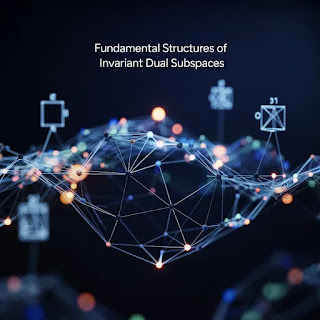🧮✨ FUNDAMENTAL STRUCTURES OF INVARIANT DUAL SUBSPACES IN BOOLEAN NETWORKS 🔁🧠
Invariant dual subspaces in Boolean networks are not just abstract concepts — they are the mathematical scaffolds upon which the network's behavior rests. Understanding them means mastering the art of prediction, control, and design in discrete systems. 🧩🔍
📘 Mathematical Foundation: Boolean Networks as Discrete Dynamical Systems
A Boolean network is a function
where is the finite field of two elements. Each node (variable) evolves over time based on a Boolean function involving other nodes:
Such networks are central in discrete mathematics, mathematical biology, and automata theory.
🧭 Invariant Subspaces: Algebraic Islands in State Space
An invariant subspace satisfies:
That is, once the network enters , all subsequent states remain in .
These can represent:
-
🔒 Fixed points:
-
🔄 Limit cycles:
-
🔁 Basins of attraction under iterative updates
In linear algebra terms, this mimics invariant subspaces of linear transformations — except we're working over a finite field and with nonlinear Boolean functions.
🔄 Dual Subspaces: Orthogonality Over
Given a vector space , its dual or orthogonal complement is:
Here:
-
🧮 The dot product is over
-
🔁 Dual subspaces capture complementary constraints
-
🧠 Invariant dual subspaces reflect symmetries and duality relations in the dynamics
This concept is rooted in linear algebra over finite fields and forms a bridge to coding theory, cryptography, and combinatorics.
🧩 Fundamental Structures: Mathematical Architecture
The fundamental structures of invariant dual subspaces involve:
🔸 Vector Space Structures:
-
Subspaces of
-
Affine subspaces formed by fixing variables or relations
🔸 Polynomial Representations:
-
Boolean functions as polynomials over
🔸 Dependency Graphs:
-
Directed graphs where edges represent variable dependencies
-
Cycles ↔ feedback loops (mathematically: strongly connected components)
🔸 Lattice-Theoretic View:
-
All subspaces of form a Boolean lattice
-
Inclusion relations model logical implication
🔬 Mathematical Tools & Theories Involved
| 🧠 Field | 🔍 Role |
|---|---|
| Linear Algebra (over ) | Orthogonality, subspaces, duality |
| Boolean Algebra | Logic operations, function design |
| Discrete Dynamical Systems | Iterative behavior, orbits, fixed points |
| Combinatorics | Configuration counts, variable dependencies |
| Algebraic Geometry over | Variety of solutions to Boolean equations |
| Graph Theory | Structure of interaction graphs |
🚀 Why It Matters in Mathematics
Studying these subspaces reveals:
-
📐 Structure in complexity: Even chaotic systems may have ordered cores.
-
🧠 Controllability: Knowing invariant subspaces helps in designing inputs.
-
🔒 Stability detection: Fixed subspaces = long-term behavior.
-
🎯 Optimization: Reduce system dimensionality by focusing on subspace dynamics.
Math Scientist Awards 🏆
Visit our page : https://mathscientists.com/
Nominations page📃 : https://mathscientists.com/award-nomination/?ecategory=Awards&rcategory=Awardee
==================
Youtube: https://www.youtube.com/@Mathscientist-03
Instagram : https://www.instagram.com/
Blogger : https://mathsgroot03.blogspot.com/
Twitter :https://x.com/mathsgroot03
Tumblr: https://www.tumblr.com/mathscientists
What'sApp: https://whatsapp.com/channel/0029Vaz6Eic6rsQz7uKHSf02





No comments:
Post a Comment